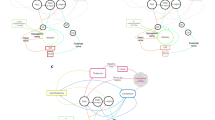Summary
The caudal neurosecretory complex of poeciliids has previously been shown to be innervated by extranuclear and intrinsic serotonergic projections. In the present study, immunohistochemical techniques were used to characterize fibers originating from serotonin neurons intrinsic to the caudal spinal cord. Bipolar and multipolar neurons were oriented ventromedially, and contained numerous large granular vesicles. Three types of serotonergic fibers were distinguished based on their distribution and morphology. Intrinsic Type-A fibers branched into varicose segments near the ventrolateral surface of the spinal cord and contacted the basal lamina beneath the leptomeninges. Type-B fibers coursed longitudinally to enter the urophysis, where they diverged and terminated around fenestrated capillaries. Labelled vesicles in Type-A and Type-B terminals were the same size as those in labelled cells and in unlabelled neurosecretory terminals in the urophysis. Type-C small varicose fibers branched within the neuropil of the caudal neurosecretory complex. Serotonin may be secreted into the submeningeal cerebrospinal fluid, the urophysis, and the caudal vein by Type-A and Type-B fibers, whereas, Type-C fibers may be processes of serotonergic interneurons in the neuroendocrine nucleus. The possibility that urotensins I and II or arginine vasotocin were colocalized in the processes of the intrinsic serotonin neurons was investigated immunohistochemically. The negative results of these experiments suggest that serotonin-containing neurons may represent a neurochemically distinct subpopulation in the caudal neurosecretory complex.
Similar content being viewed by others
References
Batten TFC (1986) Ultrastructural characterization of neurosecretory fibres immunoreactive for vasotocin, isotocin, somatostatin, LHRH, and CRF in the pituitary of a teleost fish, Poecilia latipinna. Cell Tissue Res 244:661–672
Bardon T, Ruckebusch M (1984) Changes in 5-HIAA and 5-HT levels in lumbar CSF following morphine administration to conscious dogs. Neurosci Lett 49:147–151
Bern HA, Pearson D, Larson BA, Nishioka RS (1985) Neurohormones from fish tails: The caudal neurosecretory system I. “Urophysiology” and the caudal neurosecretory system offishes. Recent Prog Horm Res 41:533–552
Bertilsson L (1987) 5-hydroxyindoleacetic acid in cerebrospinal fluid — methodological considerations and clinical aspects. Life Sci 41:821–824
Bulat M (1974) Monoamine metabolites in the cerebrospinal fluid: indicators of the biochemical status of monoaminergic neurons in the central nervous system. In: Aromatic amino acids in the brain. (Symposium) Elsevier, Holland, pp 243–264
Chan-Palay V (1976) Serotonin axons in the supra- and subepcndymal plexuses and in the leptomeninges; their roles in local alterations of cerebrospinal fluid and vasomotor activity. Brain Res 102:103–130
Cohen SL, Kriebel RM (1986) Descending serotonergic projection to the caudal neurosecretory complex. Soc Neurosci Abstr 12:1487
Cohen SL, Kriebel RM (1987) Ultrastructure of serotonin afferents to the caudal neurosecretory complex. Soc Neurosci Abstr 13:404
Cohen SL, Miller KE, Kriebel RM (1985) Localization of serotonin in the caudal neurosecretory system. Soc Neurosci Abstr 11:544
Consolazione A, Milstein C, Wright B, Cuello AC (1981) Immunocytochemical detection of serotonin with monoclonal antibodies. J Histochem Cytochem 29:1425–1430
Eldred WD, Zucker C, Karten HJ, Yazulla S (1983) Comparison of fixation and penetration enhancement techniques for use in ultrastructural immunocytochemistry. J Histochem Cytochem 31:285–292
Garelis E, Sourkes TL (1973) Sites of origin in the central nervous system of monoamine metabolites measured in human cerebrospinal fluid. J Neurol Neurosurg Psychiat 36:625–629
Groves DJ, Batten TFC (1985) Ultrastructural autoradiographic localization of serotonin in the pituitary of a teleost fish, Poecilia latipinna. Cell Tissue Res 240:489–492
Harris-Warrick RM, McPhee JC, Filler JA (1985) Distribution of serotonergic neurons and processes in the lamprey spinal cord. Neuroscience 14:1127–1140
Lamotte CC, Johns DR, deLanerolle NC (1982) Immunohistochemical evidence of indolamine neurons in monkey spinal cord. J Comp Neurol 206:359–370
Linnoila M, Jacobson KA, Marshall TH, Miller TL, Kirk KL (1986) Liquid Chromatographic assay for cerebrospinal fluid serotonin. Life Sci 38:687–694
McKeon TW, Cohen SL, Black EE, Kriebel RM, Parsons RL (1987) Norepinephrine and serotonin in the caudal neurosecretory complex: A neurochemical and immunohistochemical study. Soc Neurosci Abstr 13:404
O'Brien JP, Kriebel RM (1983) Caudal neurosecretory system synaptic morphology following deafferentation: An electron microscopic degeneration study. Brain Res Bull 10:89–95
Raynor RB, McMurtry JG, Pool JL (1961) Cerebrovascular effects of topically applied serotonin in the cat. Neurology 11:190–195
Ritchie TC, Roos LJ, Williams BJ, Leonard RB (1984) The descending and intrinsic serotonergic innervation of an elasmobranch spinal cord. J Comp Neurol 224:395–406
Scratch GP, Thomas LM, Darmody WR (1964) Cinephotomicrographic studies of the pial vasculature in the monkey and cat. Surg Forum 15:409–410
Vigh B, Vigh-Teichmann I, Aros B (1977) Special dendritic and axonal endings formed by the cerebrospinal fluid contacting neurons of the spinal cord. Cell Tissue Res 183:541–552
Author information
Authors and Affiliations
Rights and permissions
About this article
Cite this article
Cohen, S.L., Kriebel, R.M. Terminal processes of serotonin neurons in the caudal spinal cord of the molly, Poecilia latipinna, project to the leptomeninges and urophysis. Cell Tissue Res. 255, 619–625 (1989). https://doi.org/10.1007/BF00218799
Accepted:
Issue Date:
DOI: https://doi.org/10.1007/BF00218799




